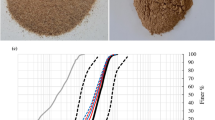Abstract
A realistic characterization of contact behavior is crucially important to the development of discrete element models of naturally occurring granular media. Although contact behavior can be inferred by adjusting the numerical simulations to agree with results from geotechnical laboratory tests, it is preferable to establish the contact laws directly with grain-scale experiments. Moreover, such an approach provides an objective way to establish the influence of characteristics such as mineralogy, microstructure, hardness, grain size, shape and surface roughness on contact behavior, and thus opens the door to a more fundamental understanding of granular media mechanics. With this motivation, we are conducting an integrated experimental/DEM modeling program with a focus on naturally occurring geologic materials. The goals of this work are to improve the physical basis of this powerful numerical modeling method, and to develop a broader understanding of the contact behavior of naturally occurring materials of interest to the geotechnical engineering community. This paper describes equipment and methods that we have developed to conduct normal contact experiments on pairs of unbonded grains of crushed and ball-milled gneiss, Ottawa sand, and lunar simulants. Contact curvatures ranged from 0.05 to 8.2 mm for the grains examined. The computer-controlled testing system applied normal forces ranging up to 10 N, and both monotonically increasing (ramp) and cyclic loading waveforms were employed. A laser proximity gauge with 100 μm resolution provided direct grain-to-grain deformation readings. The resulting force–displacement relationships showed that Hertzian behavior emerged above a normal force threshold ranging from several tenths of a Newton to several Newtons, depending on surface roughness, and approximately linear behavior was observed below the threshold for Hertzian behavior. Normal contact stiffness ranged from 0.2 to over 2 MN m−1 for forces up to 10 N, and depended on material type, local radius of curvature and surface roughness. Hysteresis was generally observed under cyclic loading and calculated values of the apparent internal friction ranged from 0.01 to 0.16, depending on material type, contact geometry and force level. The test system was capable of inducing damage in some contacts with a low radius of curvature, and it was observed that minor levels of damage typically increased stiffness and frictional loss of the contact.
Similar content being viewed by others
References
Cole, D.M., Peters, J.F.: A physically based approach to granular media mechanics: grain-scale experiments, initial results and implications to numerical modeling. Granul. Matter 9(5), 309–321. doi:10.1007/s10035-007-0046-2
Uthus. L., Tutumluer, E., Horvli, I., Hoff, I.: Influence of grain shape and surface texture on the deformation properties of unbound aggregates in pavements. Int. J. Pavements. Submitted (2006)
Nowick, A.S., Berry, B.S.: Anelastic Relaxation in Crystalline Solids, pp. 677. Academic, New York (1972)
Alonso-Marroquin, F., Herrmann, H.J.: Ratcheting of granular materials. Phys. Rev. Lett. 92(5), 054301-1–054301-3 (2004)
Mindlin, R.D., Deresiewicz, H.: Elastic spheres in contact under varying oblique forces. ASME J. Appl. Mech. 20, 327–344 (1953)
Cole, D.M., Dempsey, J.P.: Influence of scale on the constitutive behavior of sea ice. In: International Union of Theoretical and Applied Mechanics Symposium on Scaling Laws in Ice Mechanics and Ice Dynamics, pp. 251–264. Kluwer, Dordrecht (2001)
Cheng, Y.P., Bolton, M.D., Nakata, Y.: Crushing and plastic deformation of soils simulated using DEM. Geotechnique 54(2), 131–141 (2004)
Misra, A.: Mechanistic model for contact between rough surfaces. J. Eng. Mech., ASCE 123(5), 475–484 (1997)
Nakata, Y., Hyde, A.F.L., Hyodo, M., Murata, H.: A probabilistic approach to sand particle crushing in the triaxial test. Geotechnique 49(5), 567–583 (1999)
McDowell, G.R., Amon, A.: The application of Weibull statistics to the fracture of soil particles. Soils Found. 40(5), 122–141 (2000)
Deluzarche, R., Cambou, B.: Modeling grain crushing in rock fill material using discrete 2D model. In: Garcia-Rojo, R., Herrmann, H.J., McNamara, S.(eds) Powders and Grains, vol II, pp. 1409–1412. Taylor & Francis Group, London (2005)
Yoshioka, N., Scholz, C.H.: Elastic properties of contacting surfaces under normal and shear loads 2. Comparison of theory with experiment. J. Geophys. Res. 94, B12, 17,691–17,700 (1989)
Bora, C.K., Flater, E.E., Street, M.D., Redmond, J.M., Starr, M.J., Carpick, R.W., Plesha, M.E.: Multiscale roughness and modeling of MEMS interfaces. Tribol. Lett. 19(1), 37–48 (2005)
Buzio, R., Malyska, K., Rymuza, Z., Boragno, C., Biscarini, F., De Mongeot, F.B., Valbusa, U.: Experimental investigation of the contact mechanics of rough fractal surfaces. IEEE Trans. Nanobiosci. 3(1), 27–31 (2004)
Author information
Authors and Affiliations
Corresponding author
Additional information
Engineer Research and Development Center U.S. Army Corps of Engineers.
Rights and permissions
About this article
Cite this article
Cole, D.M., Peters, J.F. Grain-scale mechanics of geologic materials and lunar simulants under normal loading. Granular Matter 10, 171–185 (2008). https://doi.org/10.1007/s10035-007-0066-y
Received:
Published:
Issue Date:
DOI: https://doi.org/10.1007/s10035-007-0066-y




